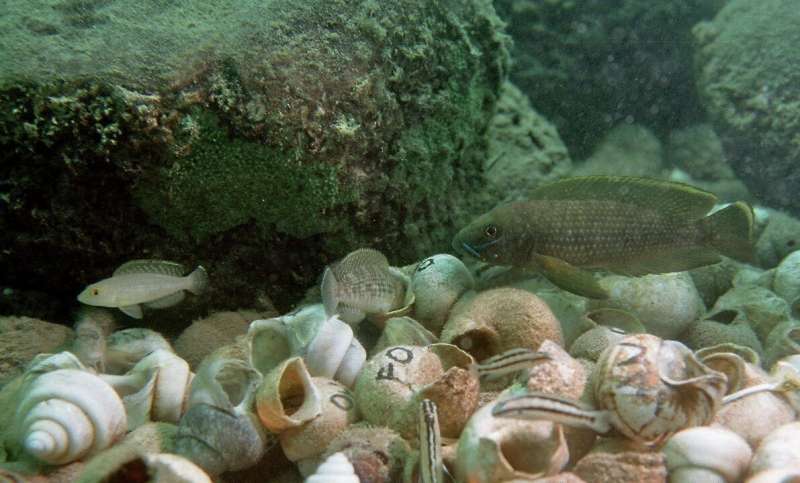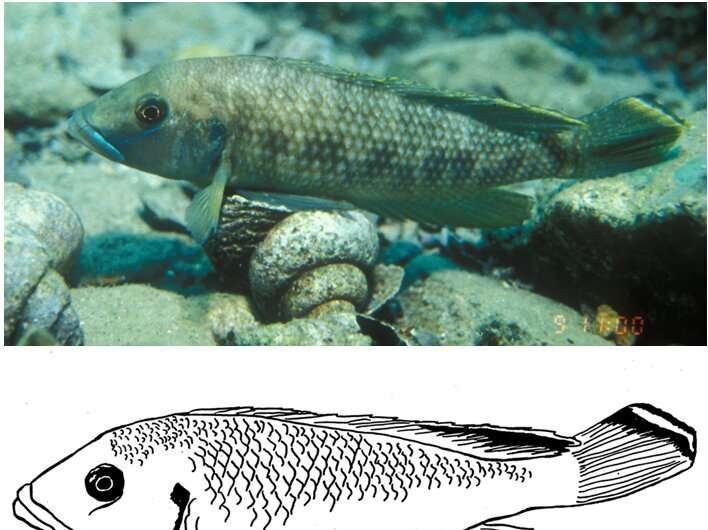This article has been reviewed according to Science X's editorial process and policies. Editors have highlighted the following attributes while ensuring the content's credibility:
fact-checked
peer-reviewed publication
trusted source
proofread
How giants became dwarfs: Exploring size difference in sexual dimorphism

Difference in body size (or sexual dimorphism) between males and females is common across the animal kingdom. One of the most extreme examples of sexual dimorphism is found in the cichlid fish species Lamprologous callipterus from Lake Tanganyika in East Africa, where males are 12 times bigger (heavier) than females.
The ecological reason for this remarkable size difference is the fact that this species uses empty snail shells found at the bottom of the lake to build nests. Hence males must be large enough to carry shells with their mouths, whereas females need to be small enough to fit inside the snail shells to lay eggs, where they are well protected from predators.
Sex-specific differences in body size are important for the biology of this species, as small males would not be able to carry empty snail shells and large females would not be able to enter the shells for breeding.
The most peculiar feature of this species, however, is the existence of a second male morph, which is 60 times smaller (lighter) than the nest-building giants. These small fellows sneak into the shells when a female is spawning, only to fertilize the freshly laid eggs there. It has already been shown that the giant nest males and the dwarf parasites only sire sons developing into the same male type as their father.
In a new study published in Molecular Ecology, Pooja Singh, formerly from the University of Graz, Michael Taborsky und Catherine Peichel, all of whom are now located at the Institute of Ecology and Evolution (IEE) of the University of Bern, and Christian Sturmbauer from the University of Graz, unraveled how the alternative sizes and different sexes are determined in these cichlids.

The genetic mechanism underlying this unique reproductive system
Genomic analyses revealed a Y sex chromosome region differing between males and females. "This was a first important step, because these cichlids lack the highly differentiated sex chromosomes we know from humans and many other animals," says Pooja Singh, first author of this publication. This was a worthwhile challenge, because thereby the early stages of sex chromosome evolution could be reconstructed in connection with a size-determining genetic mechanism that appeared to be influenced by intra- and intersexual conflict.
The researchers found that this small y-like genomic region also contained the growth hormone regulator gene GHRHR, which was intriguing. "This gene is known to serve an important regulatory function for growth in mammals, and mutations of this gene may lead to dwarfism also in humans," explains co-author Katie Peichel.
As this gene has now been identified in fishes, it probably emerged more than 440 million years ago, before aquatic vertebrates conquered terrestrial domains. In the studied snail shell brooding cichlids this size regulating gene has apparently evolved in conjunction with the sex-determining genetic loci.
Who came first, giant or dwarf?
The different reproductive roles of males and females, and of males belonging either to the nest-building or the parasitic type, suggest conflicting selective pressures yielding reproductive success dependent on body size. Concerning the male size-dimorphism, it is interesting to ponder over the most likely chronological order.
Co-author Michael Taborsky proposes that giants preceded dwarfs: "The entire reproductive system of this species depends on the essential nest-building activity of giant males, who must be large enough to collect empty snail shells. The dwarf morph could then originate by a respective point mutation in the sex and size determining region of the genome, leading to a highly successful alternative reproductive tactic."
More information: Pooja Singh et al, Genomic basis of Y‐linked dwarfism in cichlids pursuing alternative reproductive tactics, Molecular Ecology (2023). DOI: 10.1111/mec.16839
Journal information: Molecular Ecology
Provided by University of Bern

















